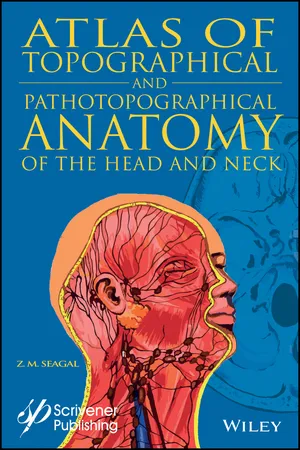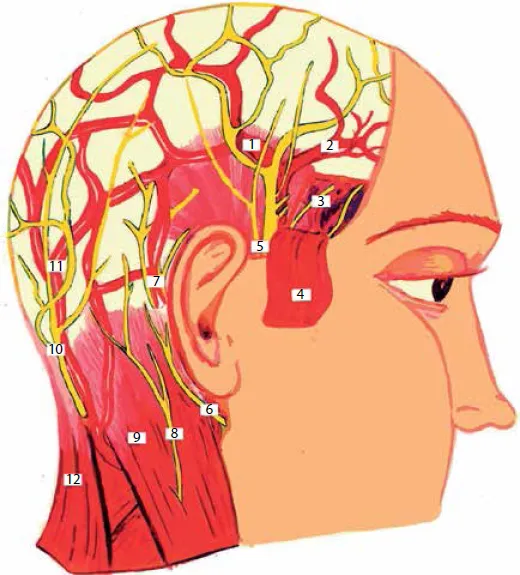
- English
- ePUB (mobile friendly)
- Available on iOS & Android
Atlas of Topographical and Pathotopographical Anatomy of the Head and Neck
About This Book
Written by an experienced and well-respected physician and professor, this new volume, building on the previous volume, Ultrasonic Topographical and Pathotopographical Anatomy, also available from Wiley-Scrivener, presents the ultrasonic topographical and pathotopographical anatomy of the head and neck, offering further detail into these important areas for use by medical professionals.
This atlas of topographic and pathotopographic human anatomy is a fundamental and practically important book designed for doctors of all specializations and students of medical schools. Here you can find almost everything that is connected with the topographic and pathotopographic human anatomy, including original graphs of logical structures of topographic anatomy and development of congenital abnormalities, topography of different areas in layers, pathotopography, computer and magnetic resonance imaging (MRI) of topographic and pathotopographic anatomy. Also you can find here new theoretical and practical sections of topographic anatomy developed by the author himself which are published for the first time. They are practically important for mastering the technique of operative interventions and denying possibility of iatrogenic complications during operations.
This important new volume will be valuable to physicians, junior physicians, medical residents, lecturers in medicine, and medical students alike, either as a textbook or as a reference. It is a must-have for any physician's library.
Frequently asked questions
Information
Part 1:
The Head
Topographic Anatomy of the Head
Cerebral Cranium
Layers of Regions and their Characteristics:
- Derma – thick, hair-covered skin, it has a large number of sebaceous and sweat glands. It is firmly attached to the deeper lying subcutaneous fat and supracranial muscle, musculus epicranius, using vertically going connective tissue septa.
- Panniculus adiposus – it’s subcutaneous fat. Blood and lymphatic vessels of this layer are firmly fixed using connective tissue septa. That’s why vessels do not collapse when injured.
- M. epicranius – it’s epicranius muscle which consists of the frontal part, m. frontalis, and the occipital part of the m. occipitatis. Both parts have shared tendon helmet, galea aponeurotica, which is located in the parietal region and becomes thinner as it goes laterally during transition to the temporal region. These three layers which were described above form a single layer of tightly interconnected tissues.
- Stratum fasciaie – it’s fascial layer, a layer of incoherent connective tissue.
- Periosteum is firmly attached to the skull bones only in the sutural areas.
- Ossa cranii are the bones of the skull of variable thickness. Occipital region bones have the maximum thickness, and the temporal bones have the minimum thickness. The skull bones are composed of three layers. It’s the lamina externa or the external plate, substantia diploica or the spongeous matter which has a lot of vessels – especially vv. diploicae, and lamina vitrea or glass-like plate.
- Spatium epidurale – it’s the space above the dura mater.
- Dura mater is composed of dense fibrous connective tissue. As it goes deeper, this tunica forms the falx cerebri or the crescent of the brain and with its help it divides cerebral hemispheres from each other; falx cerebelli or the crescent of the cerebellum divides the cerebellar hemispheres, and tentonum cerebelli or the tent of the cerebellum separates the occipital lobes of the cerebral hemispheres from the cerebellum. These processes of dura mater form channels for the drainage of venous blood from the cranial cavity which are called venous sinuses.
- Spatium subdurale is a space beneath the dura mater.
- Arachnoidea encephali or the arachnoid membrane contains blood vessels and continues from one gyrus to another without going in.
- Spatium subarachnoidaie or subarachnoid space stores cerebrospinal fluid in its subarachnoid cisterns or cisternae subarachnoidaie.
- Pia mater or the soft tunica contains a large number of vessels. The tunica finds its way inside all the sutures between the gyruses.
- Spatium epicerebrale or epicerebral space. Has the most amount of cerebrospinal liquid between all the listened above spaces.
- Gyri cerebri or brain gyruses.
Regio Frontalis Has the Next Blood Vessels (Fig. 1):
- a. frontalis is the final branch of the a. ophthatmica and leaves the cranial cavity through the frontal hole, for. frontale. A. frontalis anastomoses with the a. angularis in the corner of the eye;
- a. suproorbitalis leaves the cranium through the incisura supraorbitalis. Frontal artery lies a little bit more medially than supraorbital. Venous backflow goes through the frontal veins, vv. frontales and after that backflow continues through v. angularis and afterwards it goes on to the system of frontal facial vein. A small amount of blood keeps going to v. ophthatmica superior which pours into the cavernous sinus.

Table of contents
- Cover
- Title page
- Copyright page
- About the Author
- Introduction
- Part 1: The Head
- Part 2: The Neck
- Appendix A
- Appendix B
- End User License Agreement